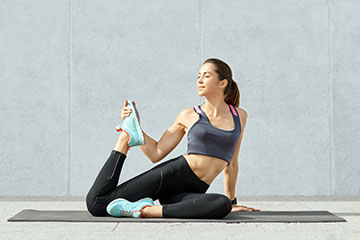A key component of a healthy lifestyle, regular exercise is critical for physical fitness, mental health, and general vitality. Proper stretching and foam rolling techniques can greatly improve the efficacy of your workouts and reduce the chance of injury, regardless of whether you are a serious athlete, a casual gym goer, or just getting started with your fitness journey.
What is stretching and Why is it Important
Stretching simply involves extending a muscle to the end of its range of motion and holding it for few seconds.
Neglecting proper stretching before or after exercise can cause injuries by making the muscles more prone to strains and rips. Tight muscles can also limit range of motion and cause joint pain. Therefore, it’s crucial to ensure that you stretch routinely before and after exercising. Make sure to prioritize stretching in your training routine because skipping stretches can result in a poor recovery from workouts.
There are two types of stretches:
- Dynamic: By actively contracting muscles and examining the whole range of joint mobility, this kind of stretching aims to enhance overall agility and performance. For best benefits, dynamic stretching should be performed before and after a workout. The type of stretching you should do will depend on the outcomes you and your trainer are aiming for. Some common examples are leg swing, walking lunges, torso twists.
- Static: Static stretching is excellent for relaxing muscles after exercise and returning them to their pre-exercise length. By holding a comfortable stretch for up to a minute and repeating it a few times throughout the cool-down, you can achieve this recovery goal. Some examples are the hamstrings stretch, shoulder stretch, and quadriceps stretch.
If you’re unsure about proper stretching techniques, there are various online resources available, or you can seek guidance from a licensed personal trainer.
What is Foam Rolling and What does it do?
Foam rolling is a crucial component of maintaining and enhancing flexibility. It helps loosen up tight muscles, tendons, and fascia, which is the web-like sheath that covers your muscles and can stiffen and restrict movement. Foam rolling also helps to increase range of motion and lessen pain.
Foam rolling is ideal for releasing tension in the fascia, ligaments, tendons, and muscles. Consider it a type of self-massage done to aid in the recuperation process after exercise. Regular rolling helps enhance blood flow to the muscles, reduce muscle tension, and remove knots. It is frequently used in the arms, back, and legs to help in post-exercise recovery and injury prevention. It is crucial to perform foam rolling correctly. Start by utilizing your own body weight to increase the pressure as you slowly roll the affected area for 15 to 30 seconds. If you come across an area that is very tight, apply pressure there for 10 to 15 seconds. Pay attention to your body and stop foam rolling if it hurts. Reevaluate your approach, use proper technique, and prioritize your well-being during the foam rolling process.
How often Should you Stretch and Foam Roll?
Your workout intensity and exercise frequency will determine how often you should stretch and foam roll. If you’re just getting started, try foam rolling or stretching once or twice a week. For best results, stretching and foam rolling should be done three to four times per week for people who are more active and routinely work out. It’s crucial to keep in mind that quality over quantity applies to foam rolling and stretching. Remember to take pauses during your workout and to stretch and foam roll as soon as you finish. This will lessen muscular discomfort and prevent you from getting hurt.
It is essential is to consult with a healthcare professional before incorporating stretching or foam rolling into your exercise routine.
